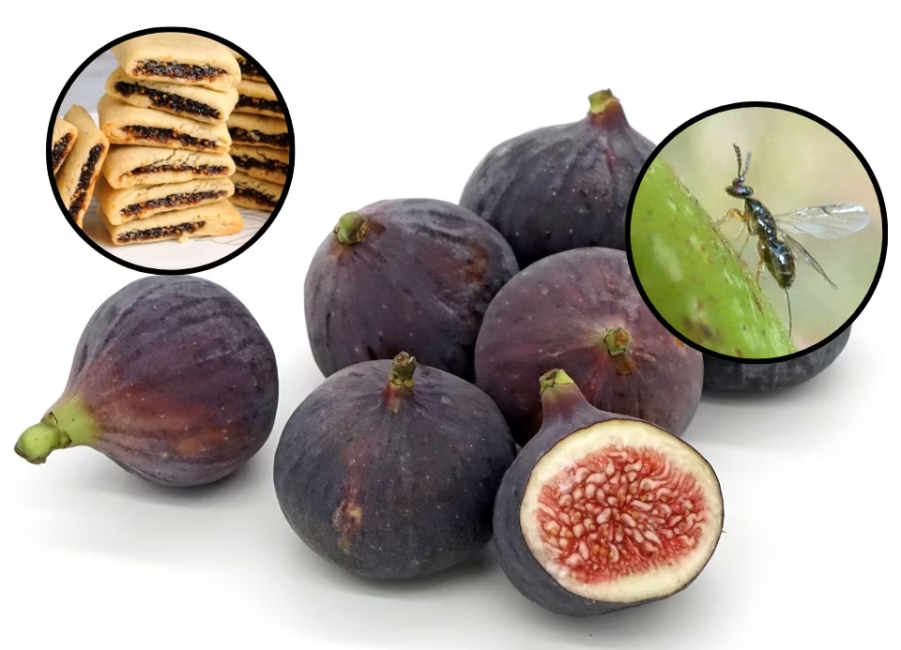If you’re a fan of Weird Nature Facts, you’ll want to stick around for this one. The most popular lecture from my recent tropical nature course in Costa Rica focused on on how figs, a delicious and ecologically important group of fruit trees, reproduce. At the center of their bizarre biology is this strange fact: many figs contain, at one time or another, tiny dead wasps. Does this mean you should be giving up fig Newtons? Absolutely not! Let’s learn more about figs, wasps, and their bizarre relationship in this Naturalist Answers post.
Some quick fig basics
Let’s start with some basics to lock in what we’re talking about. From a natural history perspective, the name “fig” refers generally to plants in the genus Ficus, which make up a large part of the Moraceae or mulberry family. These are primarily tropical plants which take a variety of shapes, including as trees, shrubs, and climbing vines. Some range outside of the tropics, particularly in the Mediterranean. Aside from their fruits, figs are especially well-known for their thick, milky sap.
Family? Genus? What do all these words mean? Check out our Beginner’s Guide to Taxonomy
Fig fruits and flowers
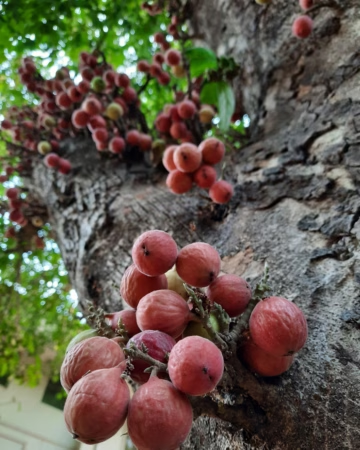
Although they have plenty of interesting characteristics, one thing tends to make figs stand out the most: their fruits, and the flowers that produce them. If you’ve ever bitten into a fig fruit, you’ll notice that it doesn’t have the same feel or structure as something like an apple or an orange. Rather than a fleshy part with some seeds in the middle, it’s kind of a mess of thread-like fleshy bits with seeds at their outer ends. This is because a single fig is actually a whole bunch, hundreds to thousands, of tiny, elongated fruits from the female parts (gynoecia) of many flowers.
Read more: What is sap, and what does it do?
Specifically, a single fig is a structure that biologists call a syconium, which is a sort of sphere of tiny fruits encompassed in a roundish package. Each of those tiny, threadlike fruits, all mushed together into the sort of teardrop-shape of the fig itself, came from a tiny flower. Those flowers have a distinctive way of blooming, however: instead of facing the outside world, they form facing toward the interior of the chamber that later becomes the fig. This key difference plays a major role in the fig’s distinctive life cycle and in why wasps end up inside of figs.
From flowers to fruit
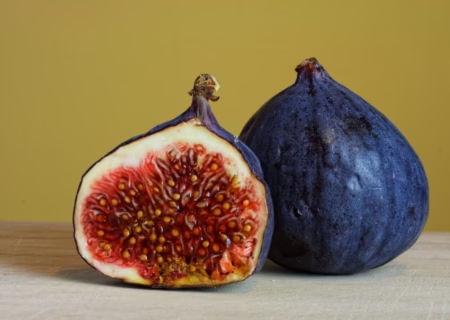
As you may know, plants typically produce flowers so allow for pollination, where pollen carrying genetic material from another plant of the same species can fertilize an egg (ovule) inside of the female parts of the flower. This allows sexual reproduction, which has lots of advantages for the plant, typically including healthier, more robust fruits and seeds that lead to a healthier next generation of plants.
Read more: What is a life cycle?
Most flowers face outward, so that pollen drifting on the wind, or carried by flying insects like bees and butterflies, can reach the flower. However, fig flowers are hidden deep inside the glob-shaped syconium, where seemingly no bees or butterflies, and certainly no airborne pollen, can reach them. So how do figs get pollinated in the first place? Now we’re getting somewhere. Enter the fig wasps!
Fig pollination: Meet the fig wasps
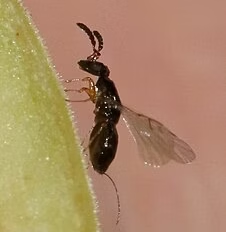
Although the syconium, that rounded structure that eventually becomes a fig, seems totally closed off to the outside world, it has one entrance: the ostiole. This is a tiny little opening at the very bottom of the capsule, seemingly too small for any more familiar pollinating insect to enter. However, figs aren’t pollinated by any of the usual suspects; their partners in crime are a weird and super-tiny group of wasps, which are appropriately called fig wasps.
Read more: 6 important pollinators other than bees
While there are a lot of different wasp species that hang out in, or reproduce inside of figs, the ones which help fig plants reproduce by pollinating their tiny flowers belong to the family Agaonidae. You guessed it: these super-small wasps are just tiny enough to crawl inside the ostiole and enter the syconium, where they can pollinate the inward-facing flowers.
Fig wasps are specially adapted to reproducing in figs, and are uniquely capable of pollinating their flowers. In this way, both the fig and the wasp are dependent on one another to reproduce and create their next generation. This dependence is a form of symbiosis or symbiotic relationship (organisms living closely associated lives). Specifically, it is a mutualism, meaning both organisms benefit from the relationship. It is such a close-knit relationship, in fact, that biologists would describe them as co-evolved; both wasps and figs had developed specific adaptations over many millions of years, such that now they are almost literally “made for each other”!
How do wasps pollinate figs?
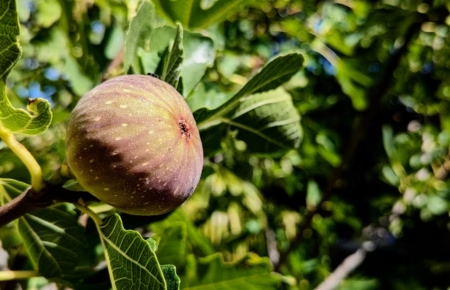
So here’s how it works:
- Female fig wasps hatch inside a ripened fig, carrying pollen from that fig’s flowers on their bodies
- They find an unripened fig and enter the hole (ostiole) in the bottom
- These females lay eggs inside the unripened fig (syconium) and pollen from their body pollinates the nearby flowers
- After laying their eggs, the female typically dies inside of the fig
- Fig wasp eggs form a gall in which the young hatch as larvae
- Once they have reached a certain side, fig wasp larvae pupate inside the fig
- Adult males emerge from their pupae first, and mate with females while they’re still pupating (!)
- Males die inside the fruit
- Females emerge from their pupae, pick up pollen in special pockets on their bodies
- Females leave the fig and look for a new, unripened fig to start the cycle again
Read more: What are galls?
Pretty wild, right? As you might notice, this complex life cycle means that quite a few wasps do end up inside of a ripened, pollinated fig. Entering the ostiole can be a rough process for the female. She may lose her wings, or even her antennae in the process! This is an early sign that this is primarily a one-way trip for her. Meanwhile, adult males that emerge from their pupae are typically wingless to begin with. They aren’t going anywhere! Their one task is to mate with the pupating females before they emerge, and they typically die shortly after completing their mission. They never even see the outside world!
Check out this video of fig wasps emerging from a tropical fig
So, when you eat a fig, are you eating wasps?
The short answer is: not really. First off, many domestic breeds of figs are and can be hand-pollinated, so no wasps are necessary. Second of all, figs can produce fruits that aren’t pollinated and the fruit can be just fine. Pollination typically makes the fruits larger and higher quality, but it’s not an absolute must. So not all figs have been pollinated by wasps in the first place.
Second of all, fig wasps’ bodies are extremely tiny, and most of the wasps involved with a fig leave the fig as it ripens. The only ones that remain are the females that came in to lay eggs, and the wingless males who mated and then died inside. However, enzymes inside of the fig plant, particularly one called Ficain, break down the bodies of the wasps such that nothing remains of them. The tiny size of the fig wasps, plus the presence of these enzymes, means you probably aren’t consuming any actual animal matter when you eat a fig.
Now that we’ve cleared up some of the basics, let’s move on to some more specific fig-eating questions.
Some common questions about wasps inside figs
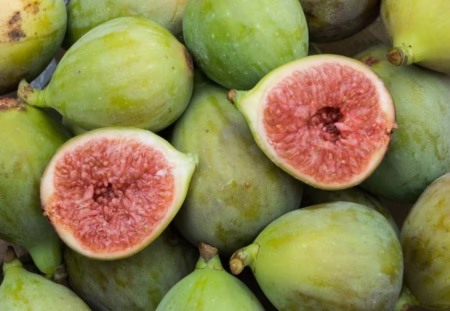
Do fig wasps carry any diseases?
No. Fig wasps do not carry any diseases or chemicals that can cause any harm to humans.
I ate a fig and there were crunchy bits. Did I just eat a wasp?
No! The crunchy parts of figs are just fig seeds. The chances of there being any parts of a fig wasp in any fig product you consume are vanishingly small.
Are figs vegan?
Some figs are not technically vegan, because at some point they may have contained some fig wasps. By the time you eat such a fig, there will typically be no parts of the fig wasps left inside. Many commercial figs are either sterile (produce non-pollinated fruit) or are hand-pollinated, further reducing the chances that you’re consuming any animal material.
It’s also important to keep in mind that no fig wasps are harmed in fig pollination. While it’s understandable to be hesitant to consume any insect parts because you may find it gross, if your veganism is based on a concern for animal welfare, any wasps that die in fig production are doing so as part of their natural life cycle. That is, they’re doing what they are meant to do, and under no other natural circumstances would they survive anyhow.
Sources and further reading
Cook, J.M., and Raplus, J.-Y. 2003. Mutualists with attitude: coevolving fig wasps and figs. Trends in Ecology & Evolution, 18(5), 241-248.
Weiblen, G.D. 2002. How to be a Fig wasp. Annual Review of Entomology 47.
Thank you!
If you enjoyed this post, please support the blog by sharing this post with friends and following the blog on Social Media. If you have a post that you’d love to see, get in touch using the Contact Page. Until next time, go get to know your natural world!

